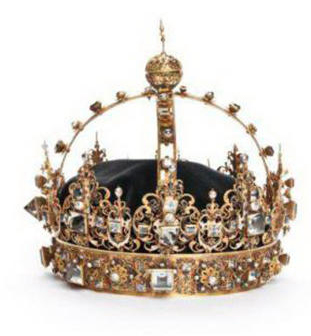Two 17th century crowns and an orb have been stolen from Strangnas Cathedral near Stockholm. The priceless objects were stolen at around noon on Tuesday, July 31.
The thieves, who entered the church during a service, smashed the glass display case setting off the alarm before stealing the jewels and escaping in a boat. The objects are being added to Interpol’s global database of stolen works of art which is accessible to all member countries in addition to authorised users from auction houses and museums.
The objects had been commissioned for the funeral of King Karl IX in 1611 and Queen Kristina, who died in 1625.
Description of the stolen jewels:
King Karl IX Orb (1611) – made of 17-carat gold and decorated with black and white enamel with rock quartz and pearls and topped with an enamel cross. Around the middle of the orb is a ribbon with alternately distributed rock quartz and pearls, with a second perpendicular ribbon set with table-cut rock quartz.
Dimensions: Height 17cm, diameter 11cm
King Karl IX Crown (1611) – made of 16-carat gold and partly covered with black and white enamel decorated with cut rock quartz and pearls. On the crown ring are eight large and eight small posts with a small, enamelled orb with a cross in the centre. In the middle of each post is a large, point cut rock quartz. Each large rock quartz on the crown ring is surrounded by four smaller ones. On the brackets are alternate rock quartz and pearls.
Dimensions: Height 25cm, diameter 19.4cm, weight 1625g
Queen Kristina Crown (1626) – made of 17-carat gold with black enamel. On the upper part of the crown ring are eight leaf-formed bows, from which the half-brackets extend. In the central part is a small orb decorated with a cross.
Dimensions: Height 12.5cm, diameter 14.7cm, weight 660g.
For more on thefts of works of art, including ‘most wanted’ posters visit the Interpol website. Interpol reports illicit trafficking in cultural objects from counties in the Middle East affected by armed conflict. The black market in works of art is becoming as lucrative as those for drugs, weapons and counterfeit goods, says Corrado Catesi, who coordinates Interpol’s efforts against cultural heritage crimes. Its Works of Art database holds information on some 50,000 items from 134 countries.










